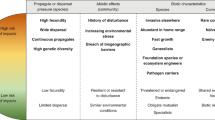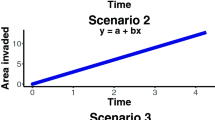Abstract
Climate change has been conclusively linked to species extinctions, and to expansion and contractions and shifts of species ranges. Climate change is exerting similarly profound pressures on the individual stages of biological invasion which can significantly impact the biodiversity and ecology of invaded areas. Propagule pressure is perhaps the single most important determinant of invasion success, but the effects of climate change on propagule pressure are still largely uncertain because we have few observations of introduction events (or their size) that can be analyzed together with climate records. The common surrogate variables for propagule pressure do not logically respond to climate. Here I use a process-based simulation model to examine the potential effects of climate change (specifically temperature) on propagule size of a common invading insect species by estimating in-transit survivorship rate of propagules using historical and future (projected) temperatures and two common trade routes between a donor and a recipient location (Yokohama, Japan and Sydney, Australia). Propagule size (=the number of individuals in an introduction event) was lower under climate change temperatures than under historical temperatures in both routes. The route had significant effects on propagule size through its influence on the duration (and also the timing) of exposure to temperature conditions that are of time-sensitive importance to the development of the invasive species. Under historical temperatures propagule size was higher and less variable in the direct than the indirect route in 20 independent iterations. Under the future temperatures propagule size was also higher in the direct route but it was more variable than in the indirect route. Increased trade is increasing the opportunities for introductions, but the results reported here suggest that climate change will have inconsistent effects on biological invasion because of the complex relationship between temperature and insect ontogeny.





Similar content being viewed by others
Notes
L. Humble (Natural Resources Canada, Canadian Forest Service); pers. comm.
http://www.cccma.ec.gc.ca/data/data.shtml; accessed December 13, 2013.
Netpas Webservice 3.0. http://netpas.net/products/product_detail_DE_EN.php.
References
Allen JC (1976) A modified sine wave method for calculating degree days. Environ Entomol 5:388–396
Bacon SJ, Aebi A, Calanca P, Bacher S (2014) Quarantine arthropod invasions in Europe: the role of climate, hosts and propagule pressure. Divers Distrib 20:84–94. doi:10.1111/ddi.12149
Brockerhoff EG, Kimberley M, Liebhold AM, Haack RA, Cavey JF (2014) Predicting how altering propagule pressure changes establishment rates of biological invaders across species pools. Ecology 95:594–601. doi:10.1890/13-0465.1
Canadian Food Inspection Agency. 2013. Asian gypsy moth (Lymantria dispar L.)—Plant protection policy for marine vessels arriving in Canada from areas regulated for Asian Gyspy Moth (Lymantria dispar, Lymantria albescens, Lymantira postalba, Lymantria umbrosa). D-95-03 (15th Revision). Government of Canada, Ottawa, ON
Capinha C, Essl F, Seebens H, Moser D, Pereira HM (2015) The dispersal of alien species redefines biogeography in the Anthropocene. Science 348:1248–1251. doi:10.1126/science.aaa8913
Cassey P, Blackburn TM, Sol D, Duncan RP, Lockwood JL (2004) Global patterns of introduction effort and establishment success in birds. Proc R Soc B Biol Sci 271:S405–S408. doi:10.1098/rsbl.2004.0199
Chapman DS, Haynes T, Beal S, Essl F, Bullock JM (2014) Phenology predicts the native and invasive range limits of common ragweed. Glob Change Biol 20:192–202. doi:10.1111/gcb.12380
Chapman DS, Makra L, Albertini R, Bonini M, Páldy A, Rodinkova V, Šikoparija B, Weryszko-Chmielewska E, Bullock JM (2016) Modelling the introduction and spread of non-native species: international trade and climate change drive ragweed invasion. Glob Change Biol. doi:10.1111/gcb.13220
Colautti RI, Bailey SA, van Overdijk CDA, Amundsen K, MacIsaac HJ (2006a) Characterized and projected costs of nonindigenous species in Canada. Biol Invasions 8:45–59
Colautti RI, Grigorovich IA, MacIsaac HJ (2006b) Propagule pressure: a null model for biological invasions. Biol Invasions 8:1023–1037. doi:10.1007/s10530-005-3735-y
Dukes JS, Mooney HA (1999) Does global change increase the success of biological invaders? Trends Ecol Evol 14:135–139. doi:10.1016/S0169-5347(98)01554-7
Gray DR (2004) The gypsy moth life stage model: landscape-wide estimates of gypsy moth establishment using a multi-generational phenology model. Ecol Model 176:155–171
Gray DR (2009) Age-dependent postdiapause development in the Gypsy Moth (Lepidoptera: Lymantriidae) life stage model. Environ Entomol 38:18–25
Gray DR (2014) Unwanted spatial bias in predicting establishment of an invasive insect based on simulated demographics. Int J Biometeorol 58:949–961. doi:10.1007/s00484-013-0678-3
Gray DR (2015) Risk reduction of an invasive insect by targeting surveillance efforts with the assistance of a phenology model and international maritime shipping routes and schedules. Risk Anal. doi:10.1111/risa.12474
Gray DR, Logan JA, Ravlin FW, Carlson JA (1991) Toward a model of gypsy moth egg phenology: using respiration rates of individual eggs to determine temperature–time requirements of prediapause development. Environ Entomol 20:1645–1652
Gray DR, Ravlin FW, Régnière J, Logan JA (1995) Further advances toward a model of gypsy moth [Lymantria dispar (L.)] egg phenology: respiration rates and thermal responsiveness during diapause, and age-dependent developmental rates in postdiapause. J Insect Physiol 41:247–256
Gray DR, Ravlin FW, Braine JA (2001) Diapause in the gypsy moth: a model of inhibition and development. J Insect Physiol 47:173–184
Hellmann JJ, Byers JE, Bierwagen BG, Dukes JS (2008) Five potential consequences of climate change for invasive species. Conserv Biol 22:534–543. doi:10.1111/j.1523-1739.2008.00951.x
Hulme PE (2009) Trade, transport and trouble: managing invasive species pathways in an era of globalization. J Appl Ecol 46:10–18
Hulme PE (2016) Climate change and biological invasions: evidence, expectations, and response options. Biol Rev. doi:10.1111/brv.12282
Hulme PE, Bacher S, Kenis M, Klotz S, Kühn I, Minchin D, Nentwig W, Olenin S, Panov V, Pergl J, Pyšek P, Roques A, Sol D, Solarz W, Vilà M (2008) Grasping at the routes of biological invasions: a framework for integrating pathways into policy. J Appl Ecol 45:403–414. doi:10.1111/j.1365-2664.2007.01442.x
Kobelt M, Nentwig W (2008) Alien spider introductions to Europe supported by global trade. Divers Distrib 14:273–280. doi:10.1111/j.1472-4642.2007.00426.x
Leonard DE (1968) Diapause in the gypsy moth. J Econ Entomol 61:596–598
Leonard DE (1981) Bioecology of the gypsy moth. In: Doane CC, McManus ML (eds) The gypsy moth: research toward integrated pest management USDA Tech Bull 1584 vol. United States Department of Agriculture, Forest Service, pp 9–29
Levine JM, D’Antonio CM (2003) Forecasting biological invasions with increasing international trade. Conserv Biol 17:322–326. doi:10.1046/j.1523-1739.2003.02038.x
Liebhold AM, Tobin PC (2008) Population ecology of insect invasions and their management. Annu Rev Entomol 53:387–408
Lockwood JL, Cassey P, Blackburn TM (2009) The more you introduce the more you get: the role of colonization pressure and propagule pressure in invasion ecology. Divers Distrib 15:904–910. doi:10.1111/j.1472-4642.2009.00594.x
Logan JA, Régnière J, Gray DR, Munson AS (2007) Risk assessment in face of a changing environment: gypsy moth and climate change in Utah. Ecol Appl 17:101–117
Meyerson LA, Mooney HA (2007) Invasive alien species in an era of globalization. Front Ecol Environ 5:199–208. doi:10.1890/1540-9295(2007)5[199:IASIAE]2.0.CO;2
Pantyukhov GA (1964) The effect of low temperatures on different populations of the brown-tail moth Euproctis chrysorrhoea (L.) and the gypsy moth Lymantria dipsar (L.) (Depidoptera: Orgyidae). Entomol Rev 43:47–55
Pitt JPW, Régnière J, Worner S (2007) Risk assessment of the gypsy moth, Lymantria dispar (L), in New Zealand based on phenology modelling. Int J Biometeorol 51:295–305
Régnière J, Nealis V (2002) Modelling seasonality of gypsy moth, Lymantria dispar (Lepidoptera: Lymantriidae), to evaluate probability of its persistence in novel environments. Can Entomol 134:805–824
Régnière J, Nealis VG, Porter KB (2009) Climate suitability and management of the gypsy moth invasion into Canada. Biol Invasions 11:135–148
Régnière J, St-Amant R, Duval P (2012) Predicting insect distributions under climate change from physiological responses: spruce budworm as an example. Biol Invasions 14:1571–1586. doi:10.1007/s10530-010-9918-1
Ricciardi A (2007) Are modern biological invasions an unprecedented form of global change? Conserv Biol 21:329–336. doi:10.1111/j.1523-1739.2006.00615.x
Sanderson ED, Peairs LM (1913) The relation of temperature to insect life. Tech Bull. No. 7, Durham, NH
Schaefer PW, Strothkamp KG (2014) Mass flights of Lymantria dispar japonica and Lymantria mathura (Erebidae: Lymantriinae) to commercial lighting, with notes on female viability and fecundity. J Lepidopterists Soc 68:124–129
Sharpe PJH, Curry GL, Demichele DW, Cole CL (1977) Distribution model of organism development times. J Theor Biol 66:21–38
Sutherst RW (2000) Climate change and invasive species: a conceptual framework. In: Mooney HA, Hobbs RJ (eds) Invasive species in a changing world, vol Island Press. Washington, DC, pp 211–240
Theoharides KA, Dukes JS (2007) Plant invasion across space and time: factors affecting nonindigenous species success during four stages of invasion. New Phytol 176:256–273. doi:10.1111/j.1469-8137.2007.02207.x
USDA APHIS-PPQ (2014a) Asian gypsy moth factsheet. Washington, DC
USDA APHIS-PPQ (2014b) Manual for agricultural clearance, section 3. Washington, USA
Walther GR, Roques A, Hulme PE, Sykes MT, Pyšek P, Kühn I, Zobel M, Bacher S, Botta-Dukát Z, Bugmann H, Czúcz B, Dauber J, Hickler T, Jarošík V, Kenis M, Klotz S, Minchin D, Moora M, Nentwig W, Ott J, Panov VE, Reineking B, Robinet C, Semenchenko V, Solarz W, Thuiller W, Vilà M, Vohland K, Settele J (2009) Alien species in a warmer world: risks and opportunities. Trends Ecol Evol 24:686–693. doi:10.1016/j.tree.2009.06.008
Williamson M (1996) Biological invasions. Chapman Hall, London
Zaslavski VA (1988) Insect development. Photoperiods and temperature control. Springer, Berlin, p 187
Acknowledgments
The author is grateful to Drs. G. Castilla, P. C. Tobin, J. A. Braine and E. Moise for their very helpful comments on an earlier draft. The author is especially grateful to two anonymous reviewers for their exceptionally helpful comments on an earlier draft.
Author information
Authors and Affiliations
Corresponding author
Rights and permissions
About this article
Cite this article
Gray, D.R. Climate change can reduce the risk of biological invasion by reducing propagule size. Biol Invasions 19, 913–923 (2017). https://doi.org/10.1007/s10530-016-1291-2
Received:
Accepted:
Published:
Issue Date:
DOI: https://doi.org/10.1007/s10530-016-1291-2




